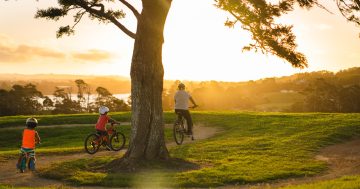
It’s like this sometimes. Photo: Claire Fenwicke.
It’s that time of year again. A week of gaping yawns and slumping at the desk lies ahead of us as we cope with that lost hour of sleep.
Daylight saving began yesterday, and if you still have mechanical clocks in the house that don’t change over automatically, you’ll be needing to refer to the old US adage, “spring springs forward, fall falls back”.
But because this means you won’t have time to lie awake in bed in the morning and ponder many of daylight saving’s impacts, we decided to put together this handy guide and answer all the deep questions you have about it.
So, what was the purpose of daylight saving?
It was the Germans who first moved the clock hands forward by one hour in April 1916 to save on artificial lighting and, therefore, fuel for the war effort. The British and French followed suit.
Technically, though, the residents of Port Arthur in Ontario, Canada (now Thunder Bay) were the first to turn their clocks forward by one hour on 1 July 1908. In April 1914, the city of Regina in Saskatchewan did the same.
Even earlier, in 1895, Kiwi scientist George Vernon Hudson presented a paper to the Wellington Philosophical Society proposing a two-hour shift forward in October and then back again in March. But it turns out no one else saw the light.
Wouldn’t it be better if it started at midnight?
Probably would. However, during World War I, in 1918, US rail companies judged that because no trains left the New York station at 2 am, there would be the least disruption to travel if the clocks moved then.
How about the fact daylight saving isn’t actually all that good for your body?
Dr Tergel Namsrai is a medical doctor and a PhD candidate at the Australian National University’s Centre for Epidemiology and Population Health, and says changing time abruptly for one hour disrupts the human body’s “internal circadian rhythm”.
This is the “internal clock of our body which depends on the dimming of the light to know what some functions shut down and start” and regulates our eating, sleeping, physical activity and metabolism.
“When our circadian rhythms don’t match the new societal clock we experience during daytime saving, it takes some time for us to adjust,” Dr Namsrai explains.
Similar symptoms to jetlag result, including “sleep disruptions, fragmentations, poor sleep quality and short sleep”.
“These changes in sleep are known to have impacts on eating patterns, glucose regulations, hormonal imbalances, and slight feelings of depression and anxiety.”

Dr Tergel Namsrai: the response to daylight saving may be similar to jetlag. Photo: Dementia Australia.
She says we “still don’t know what a decade of annual internal clock disruptions would do to human health” beyond these short-term impacts, but it may be similar to smoking, where the ill effects “are accumulated over time”.
Her suggestion to minimise the damage is to shift your bedtime or waketime by 15 minutes over the weekend – “this works really well with kids – waking them up 15 minutes earlier is a good idea”.
She also says to maintain good sleep hygiene over the period, avoid screen time or play relaxing sounds just before bed and get as much natural sunlight as possible during the day “so your body knows it’s time to be up and active”.
What if you already get up when it’s dark?
Shayna Siakimotu is a member of the ‘5 am club’. You know, those crazy – sorry, extremely hard-working and dedicated – people who get up while the sun is still happily beaming over Hawaii.
She started getting up at 5 am about five years ago, initially to get to her gym class on time, but it’s become such a habit, she finds it nearly impossible to sleep in, even on the weekend. To make it work, and ensure she still gets enough shut-eye, she goes to bed between 8 and 9 pm.
“It would be way easier if the time never changed, so I didn’t have to keep changing my clock,” she laughs.
“But yeah, it’ll be hard to get up an hour earlier next week. However, I’ll get used to it by the end of the week. I take advantage of the extra daylight at the end of the day by going for a walk, but other than that, it doesn’t change too much.”
What if you’re a shift worker?
Do you work an extra hour if your shift runs over 2 am? Or do the workers after you start earlier?
A spokesperson for Canberra Health Services (CHS) says the enterprise agreements signed by all their nurses, doctors and other employees include information on the change to daylight saving and back.
“In general, team members working an overnight shift at the beginning of daylight saving work one hour less but are paid for the full shift, while team members working an overnight shift at the end of daylight savings work an extra hour but are paid according to the clock,” the spokesperson said.
“Casual team members and team members working overtime are paid according to the actual hours worked during the shift.”
Have we missed anything?
Original Article published by James Coleman on Riotact.










